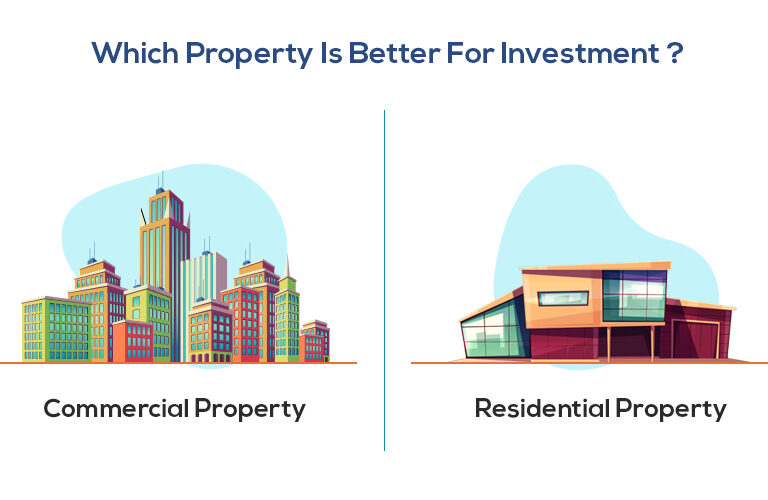Exploring the Pros and Cons of Commercial and Residential Real Estate Investment
Welcome to our blog where we delve into the fascinating world of real estate investment. Today, we're going to explore the age-old debate: commercial vs. residential investment. Whether you're a seasoned investor or a newbie exploring your options, understanding the nuances of each type of investment is crucial for making informed decisions in the dynamic real estate market.
Understanding Residential Real Estate Investment:

Residential real estate investment involves purchasing properties such as single-family homes, multi-family units, condominiums, or townhouses with the intention of generating rental income or capital appreciation. One of the main advantages of residential real estate investment is its steady demand. People will always need a place to live, providing a relatively stable income stream for investors. Additionally, financing options are often more accessible for residential properties, making it easier for individuals to enter the market.
Exploring Commercial Real Estate Investment:

Commercial real estate investment is a multifaceted realm encompassing properties utilized for business purposes. From towering office skyscrapers to sprawling industrial warehouses, and from bustling retail centers to inviting hospitality venues, the commercial sector offers a diverse array of investment opportunities. What distinguishes commercial investment from its residential counterpart is its potential for higher returns and the multifaceted nature of revenue streams it presents.
Diverse Property Types:
One of the defining features of commercial real estate investment is the wide variety of property types available for consideration. Investors can choose from an extensive range of commercial assets, each with its unique characteristics and potential for profitability.
Office Buildings: These properties cater to businesses in need of professional office space. From sleek corporate headquarters to cozy coworking spaces, office buildings offer investors the opportunity to tap into the demand for workspace in prime locations.
Retail Spaces: Retail properties encompass storefronts, shopping centers, malls, and other venues where businesses sell goods and services to consumers. Investing in retail spaces allows investors to capitalize on consumer spending trends and the allure of popular shopping destinations.
Industrial Warehouses: Industrial properties serve as logistical hubs for manufacturing, distribution, and storage operations. With the rise of e-commerce and global supply chains, demand for industrial space has surged, presenting lucrative investment opportunities for those keen on capitalizing on the logistics boom.
Hospitality Venues: From upscale hotels to budget-friendly motels, hospitality properties cater to travelers seeking accommodation and amenities during their journeys. Investing in hospitality venues offers investors the chance to participate in the vibrant tourism and hospitality industry, with potential for both short-term revenue and long-term appreciation.
Higher Rental Rates and Long-Term Leases:
Commercial leases typically involve longer terms and higher rental rates compared to their residential counterparts. This aspect of commercial real estate investment provides investors with a more predictable income stream and greater stability in cash flow.
Long-Term Leases: Commercial leases often span multiple years, providing investors with a steady stream of rental income over an extended period. Unlike residential leases, which may be subject to annual renewals, commercial leases offer greater certainty and predictability for investors.
Higher Rental Rates: Due to the business-oriented nature of commercial properties, rental rates tend to be higher than those for residential properties. Businesses are willing to pay a premium for prime commercial space that offers visibility, accessibility, and proximity to key amenities and transportation hubs.
Potential for Capital Appreciation:
In addition to generating rental income, commercial properties have the potential for significant capital appreciation over time. Prime commercial properties located in high-growth areas with strong economic fundamentals can experience robust appreciation in value, enhancing the overall return on investment for savvy investors.
Prime Locations: Commercial properties situated in prime locations experiencing economic growth and development are particularly well-positioned for capital appreciation. Urban revitalization projects, infrastructure investments, and demographic shifts can drive up property values in sought-after areas.
Value-Add Opportunities: Investors can unlock additional value and boost the appreciation potential of commercial properties through strategic renovations, repositioning, and lease renegotiations. By enhancing the functionality, aesthetics, and marketability of commercial assets, investors can maximize their returns and capitalize on emerging market trends.
Key Differences Between Commercial and Residential Investment:

Investing in commercial and residential real estate each presents unique advantages and challenges. Understanding the key differences between these two sectors is crucial for investors to make informed decisions and maximize their investment potential.
Tenant Relationships and Management:
Residential investment often entails managing multiple tenants with shorter lease terms, typically ranging from six months to a year. Dealing with turnover, maintenance requests, and tenant issues is a regular part of managing residential properties. Investors in the residential sector must possess strong interpersonal skills and a hands-on approach to address tenant needs promptly and effectively.
In contrast, commercial investment may involve fewer tenants with longer lease terms, often ranging from three to ten years or more. While commercial leases provide greater stability and predictability in cash flow, they also come with higher management responsibilities. Commercial tenants may have unique requirements and expectations, necessitating a proactive approach to property management and lease negotiations.
Market Trends and Economic Factors:
Commercial and residential real estate are influenced by different market dynamics and economic factors, requiring investors to stay abreast of industry trends and adapt their strategies accordingly.
Residential investment is closely tied to demographic trends, population growth, and housing affordability. Factors such as job opportunities, migration patterns, and interest rates can impact demand for residential properties and rental rates in specific markets. Investors in the residential sector must monitor local housing market indicators and economic data to identify opportunities and mitigate risks.
Commercial investment, on the other hand, is influenced by broader economic trends, business cycles, and industry-specific factors. Market demand for office space, retail properties, industrial facilities, and hospitality venues can fluctuate based on economic conditions, consumer behavior, and technological advancements. Investors in the commercial sector must analyze macroeconomic indicators, sector-specific trends, and market dynamics to assess investment opportunities and manage risk effectively.
while both commercial and residential real estate investment offer lucrative opportunities, they come with distinct differences that investors need to consider. Residential investment involves managing multiple tenants with shorter lease terms, while commercial investment may involve fewer tenants with longer lease terms but higher management responsibilities. Additionally, market trends and economic factors can impact each sector differently, requiring investors to stay informed and adapt their strategies accordingly.
By understanding these key differences and evaluating the unique characteristics of each sector, investors can make informed decisions and build diversified real estate portfolios that align with their investment goals and risk tolerance levels. Whether you're drawn to the stability of residential properties or the potential for higher returns in the commercial sector, thorough research and careful analysis are essential for success in the dynamic world of real estate investment.
For Latest Investment :- The Legacy by Silverglades
Factors to Consider Before Investing:

Investing in real estate, whether commercial or residential, requires careful consideration of various factors to ensure a successful and profitable venture. Before committing your capital to any property, take the time to assess the following key considerations:
1. Risk Tolerance:
Understand your risk tolerance and investment objectives before entering the real estate market. Consider factors such as your financial stability, investment horizon, and willingness to accept fluctuations in property values and rental income. Assessing your risk tolerance will help you determine the type of real estate investment that aligns with your comfort level and long-term financial goals.
2. Investment Goals:
Define your investment goals and objectives to guide your decision-making process. Are you looking to generate steady rental income, achieve capital appreciation, or diversify your investment portfolio? Clarifying your investment goals will help you identify suitable properties and tailor your investment strategy to achieve desired outcomes.
3. Financial Capabilities:
Evaluate your financial capabilities, including available capital, borrowing capacity, and cash flow projections. Determine how much you can afford to invest in real estate without compromising your overall financial stability. Consider factors such as down payment requirements, financing options, closing costs, and ongoing expenses associated with property ownership.
4. Market Analysis:
Conduct thorough market analysis to assess local real estate trends, supply-demand dynamics, and economic indicators. Research factors such as population growth, job market conditions, rental vacancy rates, and median home prices to identify investment opportunities and potential risks. Analyzing market data will help you make informed decisions and identify undervalued properties with strong growth potential.
5. Legal and Regulatory Requirements:
Familiarize yourself with legal and regulatory requirements governing real estate transactions and property ownership in your target market. Understand zoning regulations, building codes, landlord-tenant laws, and tax implications associated with commercial and residential properties. Consult with legal professionals and real estate advisors to ensure compliance and mitigate legal risks.
6. Maintenance and Management Responsibilities:
Consider the maintenance and management responsibilities associated with each type of investment property. Residential properties may require ongoing maintenance, repairs, and tenant management, whereas commercial properties may involve leasing negotiations, property maintenance, and tenant relations. Assess your ability to handle property management tasks yourself or consider outsourcing to professional property management companies.
Before diving into either commercial or residential real estate investment, it's essential to assess your risk tolerance, investment goals, and financial capabilities. Conduct thorough market analysis, research local trends, and consider legal and regulatory requirements to identify opportunities and mitigate risks. Evaluate the maintenance and management responsibilities associated with each type of investment property to ensure you can effectively manage your portfolio and maximize returns. By carefully considering these factors, you can make informed investment decisions and embark on a successful journey in the dynamic world of real estate investment.
